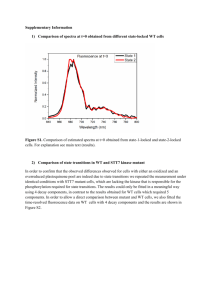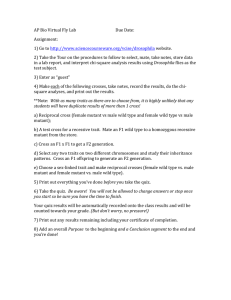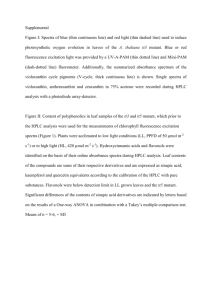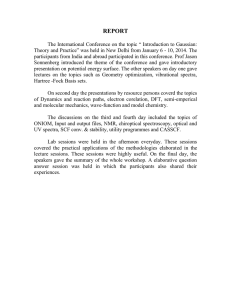Low temperature spectroscopy of a reaction center mutant
advertisement
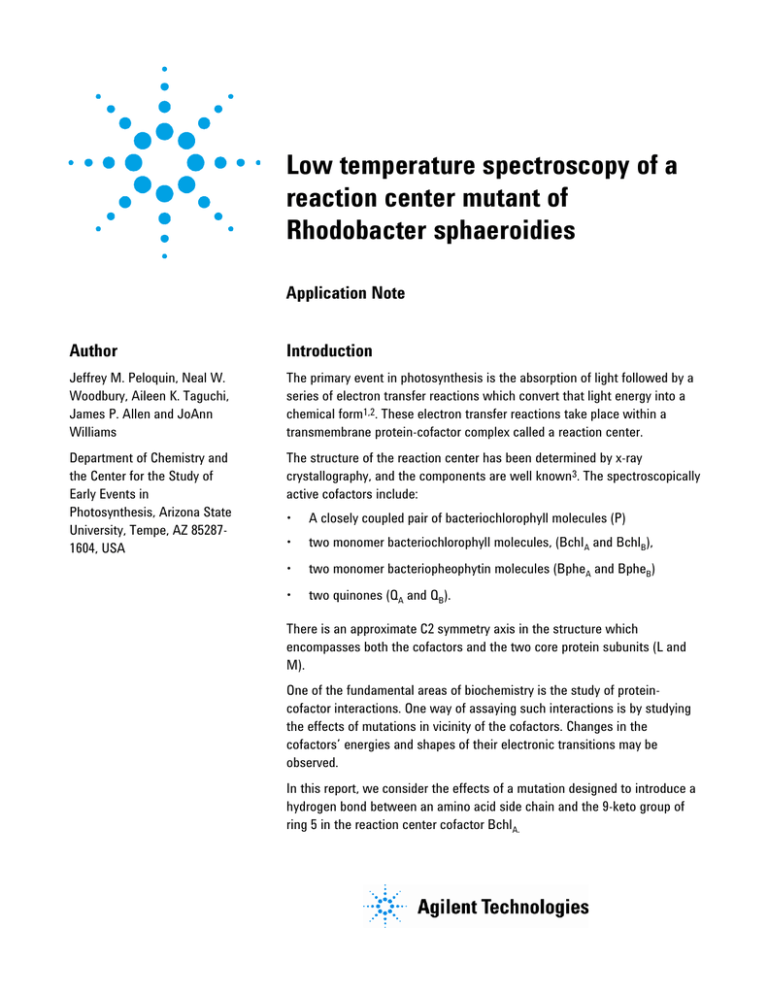
Low temperature spectroscopy of a reaction center mutant of Rhodobacter sphaeroidies Application Note Author Introduction Jeffrey M. Peloquin, Neal W. Woodbury, Aileen K. Taguchi, James P. Allen and JoAnn Williams The primary event in photosynthesis is the absorption of light followed by a series of electron transfer reactions which convert that light energy into a chemical form1,2. These electron transfer reactions take place within a transmembrane protein-cofactor complex called a reaction center. Department of Chemistry and the Center for the Study of Early Events in Photosynthesis, Arizona State University, Tempe, AZ 852871604, USA The structure of the reaction center has been determined by x-ray crystallography, and the components are well known3. The spectroscopically active cofactors include: A closely coupled pair of bacteriochlorophyll molecules (P) two monomer bacteriochlorophyll molecules, (BchlA and BchlB), two monomer bacteriopheophytin molecules (BpheA and BpheB) two quinones (QA and QB). There is an approximate C2 symmetry axis in the structure which encompasses both the cofactors and the two core protein subunits (L and M). One of the fundamental areas of biochemistry is the study of proteincofactor interactions. One way of assaying such interactions is by studying the effects of mutations in vicinity of the cofactors. Changes in the cofactors’ energies and shapes of their electronic transitions may be observed. In this report, we consider the effects of a mutation designed to introduce a hydrogen bond between an amino acid side chain and the 9-keto group of ring 5 in the reaction center cofactor BchlA. Experimental side access by the cryostat. The entire cryostat head was mounted on an X-Z translation system facilitateing alignment of the sample in the light path of the spectrophotometer. Equipment Microcentrifuge 15 mm pathlength quartz cuvette ADP Helium displex refrigerator Minco thermofoil heater Cu-Au thermocouple Scan rate 1 nm/min APD series 8000 temperature controller Detector change 680 nm Cary 5 spectrophotometer UV-Vis SBW 2 nm NIR SBW 2.5 nm All measurements were performed with air in the reference beam of the spectrophotometer. The following parameters were used: Reagents Buffer solution of 67% glycerol, 17 mM Tris pH 7.0, 0.33% lauryldimethylamine oxide (LDAO) and 3 mM EDTA. The Cary was operated in ‘Fixed SBW’ mode which held these bandwidths constant and varied the detector gain. Method Two baseline corrections were performed on the spectra: Note: The site directed mutagenesis of the pufM gene of Rb. sphaeroides converting the codon encoding glycine M203 to a codon for aspartic acid will be described elsewhere. 1. All spectra were corrected by a constant offset to set the absorbance at 1000 nm to zero. 2. An additional wavelength-independent correction was made at wavelengths below the detector change-over to correct for the small offset caused by the detector change. 1. Reaction centers were isolated from a reaction center deletion strain of Rb. Sphaeroides complemented with a recombinant plasmid bearing the altered puf operon (also to be described elsewhere). 2. Reaction centers were resuspended in a buffered solution containing 67% glycerol, 17 mM Tris pH 7.0, 0.33% LDAO and 3 mM EDTA. 3. Air bubbles were removed by centrifugation in a microcentrifuge for 3 minutes at 4000 rpm. 4. The optical density at 800 nm was approximately 0.5 in a 0.15 cm quartz cuvette mounted to the cold tip of a helium displex refrigerator. Temperatures were maintained using a thermofoil heater atttached to the cold tip and monitored with a calibrated Cu-Au thermocouple. Both the heater and the thermocouple were controlled using a series 8000 temperature controller. The front panel of the Cary 5 spectrophotometer sample chamber was removed for 2 Results 1. At 20 K the long wavelength transition at about 885 nm (20 K) in the wild type has shifted to roughly 895 nm in the mutant. In addition, the mutant shows a more pronounced shoulder on the long wavelength side of the 800 nm peak. This shoulder can be seen clearly in the 120 K-20 K difference spectra (dotted lines). Figures 1A to C show the low temperature optical absorbance spectra taken with a Cary 5 spectrophotometer. 2. A clear peak is observed at 815 nm in the mutant which is absent in the wild type spectrum. Figure 1C compares the wild type and mutant spectra in the visible region. Here again a clear splitting is observed in the 600 nm band at 20 K. Discussion In native reaction centers from Rb.sphaeroides there is a hydrogen bond between a glutamic acid (L104) and the ring V, 9-keto group of BpheA. No such hydrogen bond is found with the 9-keto group of BpheB. This results in the splitting observed in the visible (530-550 nm) transition of bacteriopheophytin at low temperature (Figure 1C and Reference 4) as well as some of the asymmetry observed in the near infrared band of the reaction center bacteriopheophytins at roughly 760 nm (Figures 1A and B). Upon introduction of an aspartic acid near the 9-keto group of ring V in BchlA of the reaction center, a similar splitting is observed in the visible transition of bacteriochlorophyll near 600 nm (Figure 1C) and a distinct asymmetry is introduced in the monomer bacteriochlorophyll transition near 800 nm in the reaction center spectrum (Figure 1B). These observations are consistent with the conclusion that a hydrogen bond has been formed between the ring V, 9keto group of BchlA and the aspartic acid introduced at M203 as predicted. Figure 1A. The near infrared spectrum of wild type reaction centers at 120 K (dashed line) and 20 K (solid line). The dotted line represents the difference between the 120 K and the 20 K spectra Figure 1 B. The near infrared spectrum of M203GD mutant reaction centers at 120 K (dashed line) and 20 K (solid line). The dotted line represents the difference between the 120 K and the 20 K spectra Figure. 1 C. Visible optical absorbance spectra of wild type (dotted line) and M203GD (solid line) reaction centers at 20 K Figure 1A and B show the steady-state absorption spectra of both wild type reaction centers and reaction centers in which amino acid M203 (normallly a glycine) has been replaced by an aspartic acid. (This mutation is referred to as M203GD.) Spectra were taken at both 120 K (dashed line) and at 20 K (solid line). The red-shift in the 885 nm band of the reaction center is more difficult to understand. This transitions largely due to the lower excitonic state of the closely coupled bacteriochlorophyll dimer, P. M203 in the vicinity of P, and could conceivably stabilize the excited singlet state of P resulting in a red shift of the 885 nm transition. There are two clear differences between the wild type and mutant spectra: 3 The two most likely indirect mechanisms for inducing the shift in the 880 nm band are: 1. some structural change in the reaction center which results in better coupling between the two bacteriochlorophylls of the dimer, 2. or an electronic interaction between the dimer and BchlA which is perturbed upon formation of a hydrogen bond with the 9-keto group of BchlA. Further studies of this mutant and others like it will help to determine in more detail the effects of both direct and indirect interactions between reaction center cofactors and the surrounding protein matrix. References 1. Kirmaier, C., Holten, D., Photosynth, Res. 1987, 13, 225-260 2. Parson, W.W., Key, B, in “Photosynthesis: Energy Conservation by Plants and Bacteria,” 1982, Vol. 1, (Govindjee, ed.), Academic Press, New York, pp, 331-385 3. Feher, G., Allen, J.P,, Okamura, M.Y., Rees, D.C., Nature, 1989, 339, 111-116 4. Bylina, E.J., Kirmaier, C., McDowell, L,, Holten, D., Youvan, D.C. Nature, 1988, 336, 182-184 www.agilent.com/chem © Agilent Technologies, Inc., 1992, 2011 Published March, 2011 Publication Number SI-A-1117
